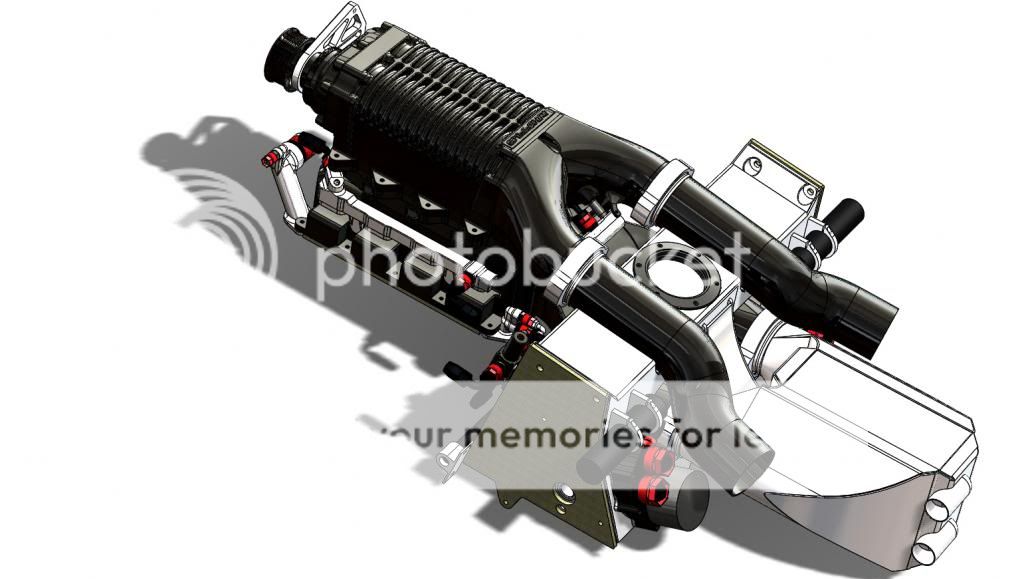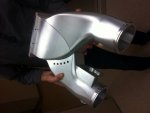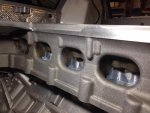It would be, in my opinion, rare to get that kind of answer on any of the other automotive forums on the internet. :lol
Fubar's GT Build
- Thread starter Fubar
- Start date
You are using an out of date browser. It may not display this or other websites correctly.
You should upgrade or use an alternative browser.
You should upgrade or use an alternative browser.
BlackICE
GT Owner
Many fluid pumps used in cars depend on some coolant, usually ethylene glycol with some additives to not only raise the boiling point, but to lubricate and reduce cavitation of the pump and to prevent corrosion of the system. Running the coolant in direct contact with ice dilutes and coolant possibly causing problems with the pump lifespan and throughput. Boiling for the intercooler is rarely an issue. To eliminate this problem with the cost of complexity and loss of efficiency you and use another heat exchanger and pump to separate the ice water from the intercooler coolant. A custom water tub and heat exchanger in place of the trunk liner was my thought.
I didn't really think about the about intercooler water needed an additive but you are right, it does need something to act as a lubricant. I will probably just use some water wetter in conjunction with straight water. It has a pretty low recommended ratio so I don't think I will see lingering issues. I'll just try to put a bottle in there when we flush the system (thoughts are that we flush the system on back-to-back runs). The Meziere water pump is mounted for easy access on this tank so any issues should be easy to assess.
And yes, DBK you are right, I would not expect this type of well thought out response on many other websites.
And yes, DBK you are right, I would not expect this type of well thought out response on many other websites.
Last edited:
I think Indy has never used liquid nitrogen for practical purposes. Any amount of LN2 will evaporate quickly - LN2 in a styrofoam cup will go in a matter of minutes. My point was to run the water lines through a LN2 tank to cool much faster and in a much smaller volume and weight than ice (discounting BlackIce - ha, ha). We routinely use LN2 to snap freeze muscle biopsies to be sent to larger medical centers. LN2 is used routinely to freeze off warts and other skin ditzels. LN2 is used to store all tissue cultures and bone marrow for transplant. It's not corrosive. You don't need to circulate it, and the size of the tank used can be very small with great effect. I think dry ice would probably work as well, but you need gloves to handle, and the James Bond effect would be lost.
^^^or a small CO2 tank, which is cheap and readily available for refills (beverage or fire extinguisher supply). Gas laws apply to all gases.
BlackICE
GT Owner
I read it as the Liquid Nitrogen is so cold in it's liquid state that at the heat exchange interface, it will cause the water side to ice up, slowing or stopping flow.
Moving water is much harder to freeze. The trick is find the right combination of water flow/pressure to LN2 exposure (i.e. a smaller LN2 tank with fast water flow or higher pressure would be hard to freeze).
MoTeC Magic
Spectator
Moving water is much harder to freeze. The trick is find the right combination of water flow/pressure to LN2 exposure (i.e. a smaller LN2 tank with fast water flow or higher pressure would be hard to freeze).
Hi Guys,
Liquid nitrogen is an option... along with other forms of removing heat like dry ice baths, etc...
We choose the simple ice water bath because of over a decade of success using it, ease of obtaining ice and water, cost, effectiveness in achieving our ideal inlet temps, etc...
We use distilled water and ice at the track... sometimes with a wetting agent... and then flush and replace with coolant/distilled water for the street. We aren't concerned with the lack of lubricity for those short time periods but that is why it is replaced with coolant for street cars.
The other issues are liquid nitrogen "shocking" the metal of the intercooler... effectively breaking it. Modern, efficient ICs are aluminum. We all know LN2s ability to make items quite brittle at reduced temperatures.
Another issue is getting the inlet air to the motor too cold. It can occur and we have found that point experimenting during previous years of racing. There are significant issues in atomizing fuel (gasoline and alcohol fuels) in temps at or below 50F. Essentially the fuel doesn't vaporize into smaller droplets for complete burn and you end up with random lean mixtures cylinder to cylinder and cycle to cycle because the fuel cannot be effectively accessed in big globs. Basically it burns the outside of the large glob of fuel and doesn't have time to get to the inside. 50F is a little too cold for lower compression motors... 70F suits them much better... 50F is pushing the limit but is handled and works very well in heavily boosted (40psi+) engines with elevated compression (14:1ish). A carbureted engine in cold temperatures is a good example... they run quite poorly until engine temps elevate to help vaporization. Modern fuel injection significantly richens the fuel mixture to make up for the fuel that doesn't vaporize during cold engine temp operation. This is fine for normal driving but under big power it is still inconsistent and simply richening the mixture for cold air temps is not a viable solution.
I believe dry ice is also insulated by the C02 bubbles in water... usually dry ice mixtures use baths other than water and get substantially cooler.
Anyway... just my .02 and a few points on why we choose ice water baths over other methods
Cheers
MoTeC Magic
Spectator
Frank poses an interesting question. But let’s look at the physics of the postulate.
Liquid nitrogen (LN2) boils (transforms from a liquid to a gas) at -321°F (-196°C) and since you want to cool off liquid water which is to be, after cooled, pumped through the I/C, you want to keep the nitrogen a liquid, thus a fluid temperature of lower than -321°F is necessary. Mark states he has a I/C tank capacity of 10 gallons.
I would imagine to cool the 10 gallons of I/C water some sort of “worm” heat exchanger (same thing moonshiners use or the old fuel line cool cans used) within the I/C tank would be necessary if you wanted to keep the nitrogen segregated from the water. I think if you just introduced or bubbled LN2 into the water the water immediately around the injection point would freeze immediately eventually creating a brick of ice effectively sealing off further introduction of LN2 into the I/C can.
If you were to circulate LN2 through a worm in the I/C tank, ice would immediately form on the outside of the worm surface getting thicker with time and “insulating” the worm from effectively pulling heat out of the water. Same effect if you introduced LN2 at the inlet of the worm and let it flash to a gas as it traversed the worm and a gas was dumped overboard. There is just too large a temperature difference between LN2 and the water to materially lower the temperature of 10 gallons of water.
And as an aside to lower the temperature of 10 gallons of water from an assumed ambient temperature of 80°F to say 40°F to go into the I/C, it would require the removal of 3,338 BTU’s of energy. Putting a time factor on how quickly the water cool down is to take place, to remove this heat in 60 minutes would require about 1.3 horsepower, 30 minutes = 39 horsepower and to cool 10 gallons of water a delta of 40°F in one minute would require about 79 horsepower.
Good question Frank, but IMO Mark should just stick with direct contact of the I/C fluid with ice. :wink
Agreed Indy... thanks for the well "formulated" input
Shawn, another good point on target induction air temperature of around 70F and further supports my earlier observation you and your team "think" about the multitude of variables affecting engine air.
I'll have a sidebar with Frank soon to discuss LN2 application.....
I'll have a sidebar with Frank soon to discuss LN2 application.....
Ah, I never considered the fuel getting too cool. That's good to know and a very helpful explanation - but - not very James Bond.
Alright, it took a really long time to find a 5-axis shop that was willing to take on this project at a price point that made sense. The 5-axis shops are used to government checks and F1 budgets. Here is the latest big item we received. Basically this item allows us to begin putting everything back together.
Attachments
Here is a shot of the work Fish did to enlarge and match the intake port to the head piece. You gotta hand to Fish, he doesn't miss any of the details. In spite of the extremely long build time, I feel really good about the guy doing the work.
This added about ¼" to the overall diameter of each port.
This added about ¼" to the overall diameter of each port.
Attachments
shelbyelite
PERMANENTLY BANNED
- May 10, 2007
- 1
Dude, your engine build is insane but the cars gonna be eligible for antique tags by the time you finish it... 
I know, sometimes I get mad at myself about it but there is nothing I can do to change my decision to take this on. I also get enjoy a dimension of the Ford GT that many owners are not able/willing/inclined to explore.Dude, your engine build is insane but the cars gonna be eligible for antique tags by the time you finish it...
BlackICE
GT Owner
I think during the last year Mark has driven his FGT about as much as you drove yours when you owned it. :lolYou keep on keepin' on. That car will be i-n-s-a-n-e when it's done.
Both in the best color as well!
MoTeC Magic
Spectator
Well... It looks like Mark is letting some secrets out early! 
You guys are getting a sneak peak prior to the system's first public appearance at PRI in December. The car won't be "finished" or running at that point, but all the major components will be in place, displaying the new system at the show. It's been a long road to this point, but we're excited to be so close to reveling one of the projects that what we've been working so hard for so long on.
Thank you for the support.
Most have NO IDEA how much goes into producing something like this to the level it is being built at. Nothing is off the shelf. 95%+ of the system is designed from scratch. There is a phenomenal amount of our engineering and CAD labor to design all the elements of this system.
Some may ask, why go through the effort?... Our goal has and is to produce turbo GT power levels with screw charger throttle response and drivability. This requires a totally different approach to the way the screw system works to avoid some of the traditional limitations inherent with screw chargers. I believe in the saying: If you want the results everyone else gets, do what everyone else does. If you want better results, do things differently. Anything great is never easy, and anything easy is never great.
Aside of the number of hours to design this system (Engineering and CAD), and the hours to create this system (fabrication and assembly), there is the expense. You all can imagine Mark has a healthy amount of cash in this project... but most don't know that we are fronting a TON of the development cost for this build as well... our engineering time, CAD time, prototyping, CAM programing, and machining. That new 5 axis machined part Mark just posted for example... was first quoted at $26,000, the second shop quoted $21,000. Obviously that's absurd, but it took time to line out reasonable manufacturing processes for parts that are reproducible at reasonable cost. Point is we all know the old adage, "Time and Money". It takes both, and Mark and I are both heavily invested in each.
I hope that as the uniqueness of the system and the quality of the work is revealed, along with the final results of the project, coupled with the understanding of what is involved in this process... that a respect for the timeline will develop.
Most shops don't allow a public display of their prototyping processes, especially on something as complex as this build, for obvious reasons seen in this thread... but I know that I can speak for Mark and myself in saying that we are both extremely passionate about what we do and really enjoy sharing the process and evolution of his car with the forum.
All the best
PS... Last sneak peek pics until the show!




You guys are getting a sneak peak prior to the system's first public appearance at PRI in December. The car won't be "finished" or running at that point, but all the major components will be in place, displaying the new system at the show. It's been a long road to this point, but we're excited to be so close to reveling one of the projects that what we've been working so hard for so long on.
You keep on keepin' on. That car will be i-n-s-a-n-e when it's done.
Thank you for the support.
Most have NO IDEA how much goes into producing something like this to the level it is being built at. Nothing is off the shelf. 95%+ of the system is designed from scratch. There is a phenomenal amount of our engineering and CAD labor to design all the elements of this system.
Some may ask, why go through the effort?... Our goal has and is to produce turbo GT power levels with screw charger throttle response and drivability. This requires a totally different approach to the way the screw system works to avoid some of the traditional limitations inherent with screw chargers. I believe in the saying: If you want the results everyone else gets, do what everyone else does. If you want better results, do things differently. Anything great is never easy, and anything easy is never great.
Aside of the number of hours to design this system (Engineering and CAD), and the hours to create this system (fabrication and assembly), there is the expense. You all can imagine Mark has a healthy amount of cash in this project... but most don't know that we are fronting a TON of the development cost for this build as well... our engineering time, CAD time, prototyping, CAM programing, and machining. That new 5 axis machined part Mark just posted for example... was first quoted at $26,000, the second shop quoted $21,000. Obviously that's absurd, but it took time to line out reasonable manufacturing processes for parts that are reproducible at reasonable cost. Point is we all know the old adage, "Time and Money". It takes both, and Mark and I are both heavily invested in each.
I hope that as the uniqueness of the system and the quality of the work is revealed, along with the final results of the project, coupled with the understanding of what is involved in this process... that a respect for the timeline will develop.
Most shops don't allow a public display of their prototyping processes, especially on something as complex as this build, for obvious reasons seen in this thread... but I know that I can speak for Mark and myself in saying that we are both extremely passionate about what we do and really enjoy sharing the process and evolution of his car with the forum.
All the best
PS... Last sneak peek pics until the show!




Last edited:




